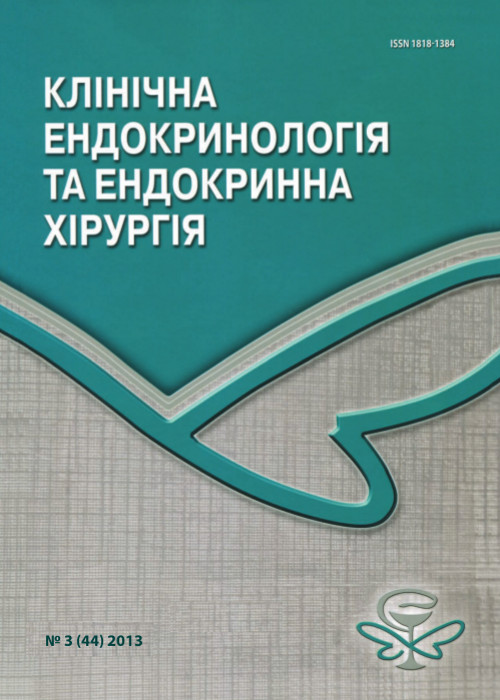Оцінка взаємозв'зків між інсулінорезистентністю, ендотеліальною дисфункцією, дисліпідемією, вмістом адипонектину і С-реактивного білка у хворих на цукровий діабет 2-го типу
DOI:
https://doi.org/10.24026/1818-1384.3(44).2013.77817Ключові слова:
diabetes mellitus, insulin resistance, endothelial dysfunction, dyslipidemia, adiponectin, C-reactive proteinАнотація
Under a supervision there were 80 patients with type 2 diabetes mellitus (DM) in age from 41 to 74. It is set that for patients with newly diagnosed type 2 DM in combination with obesity there are hyperglycemia, hyperinsulinemia and insulin resistance (IR). Maximal hyperinsulinemia is marked at disease duration up to 5 years. At duration of disease the insulin secretion goes down from 6 to 10 years, and IR increases. For patients with newly diagnosed type 2 DM the atherogenic type IIb dyslipidemia was marked. Hypoadiponectinemia assists to IR development, forming the atherogenic lipid profile and endothelial dysfunction, bulge of intima-media complex. Between IR and endothelial dysfunction from data of correlation analysis there is high positive connection that increases with the increase of DM duration for women. By principal reasons of endothelial dysfunction the type 2 DM patients during the moment of diagnosis have a chronic hyperglycemia, IR, dyslipidemia, hypoadiponectiemia, vascular inflammation.
Посилання
Вербовой А.Ф. Взаимосвязь адипонектина, эндотелина и инсулинорезистентности у больных ожирением и сахарным диабетом 2 типа / А.Ф. Вербовой, А.С. Осина // Ожирение и метаболизм. – 2010. – №2. – С. 45-48.
Cranberry M.C. Cardiovascular risk factors associated with insulin resistance: effects of oral antidiabetic agents / M.C. Cranberry, V.A. Fonseca // Am. J. Cardiovasc. Drugs. – 2005. – Vol. 5. – P. 201-209. https://doi.org/10.2165/00129784-200505030-00006
Duncan B.B. Adiponectin and the development of type 2 diabetes: the atherosclerosis risk in communities study / B.B. Duncan, M.I. Schmidt, |J.S. Pankow et al. // Diabetes. – 2004. – Vol. 53. – P. 2473-2478. https://doi.org/10.2337/diabetes.53.9.2473
Falasca K. Associations between hypertriglyceridemia and serum ghrelin, adiponectin, and IL-18 levels in HIV-infected patients / K. Falasca, M.R. Manigrasso, D. Racciatti et al. // Ann. Clin. Lab. Sci. – 2006. – Vol. 36. – P. 59-66.
IDF Diabetes Atlas Update 2012. – http://www.idf.org/diabetesatlas/5e/Update 2012
Mugabo Y. The connection between C-reactive protein (CRP) and diabetic vasculopathy. Focus on preclinical findings / Y. Mugabo, L. Li, G. Renier // Curr. Diabetes Rev. – 2010. – Vol. 6. – P. 27-34. https://doi.org/10.2174/157339910790442628
Ostrowska L. Effect of diet and other factors on serum adiponectin concentrations in patients with type 2 diabetes / L. Ostrowska, J. Fiedorczuk, E. Adamska // Rocz. Pansrw. Zakl. Hig. – 2013. – Vol. 64. – P. 61-66.
Sun H.J. Serum adiponectin and type 2 diabetes: A 6-year follow-up cohort study / H.J. Sun, W.A. Chul, S.P. Jong et al. // Diabetes Metab. J. – 2013. – Vol. 37. – P. 252-261. https://doi.org/10.4093/dmj.2013.37.4.252
##submission.downloads##
Опубліковано
Номер
Розділ
Ліцензія
Авторське право (c) 2017 Клінічна ендокринологія та ендокринна хірургія

Ця робота ліцензується відповідно до Creative Commons Attribution-NonCommercial 4.0 International License.





